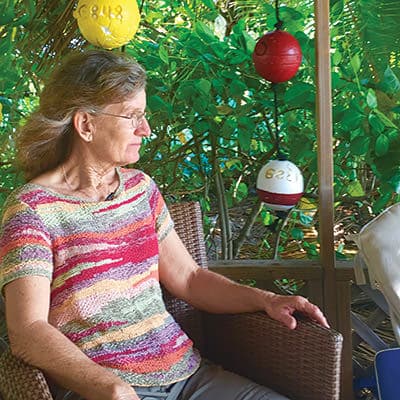Mimi Stafford

My first glimpse of the beautiful turquoise waters of the Florida Keys in 1960 began a lifelong love affair with the ocean. Annual visits with my family through the next decade reinforced that passion and led me to embark on a degree in marine biology. Newly graduated and married to my college sweetheart, I returned to the Keys in the early 1970s to share my special place and it was soon evident that the Keys would be our permanent home.
Marine science jobs were scarce in the early 70s, but we were resourceful. Over the decades we have made our living diving, fishing, sponging, trapping, and chartering. Our two children were born and raised here and share our love for the sea. My daughter became an environmental economist and teaches at the University of New South Whales in Sydney, Australia, while our son is a true conch in heart and spirit and is now the captain of our lobster boat here in Key West.
My children were fortunate to be able to experience the glory of the beautiful ocean filled with healthy corals and an abundant ecosystem, but I question whether my grandchildren will be as lucky. The decline of the marine environment of the Keys and elsewhere has been accelerating due to climate change, bleaching, coral diseases, and increased storm damage. Sometimes the challenges seem too great to overcome.

When the first discussions began about creating a sanctuary in the Keys back in the early 1990s, I was hesitant to support the idea, because we were all used to our freedom and the environment seemed resilient enough to recover from sporadic die-offs. But an honest assessment of the growing population pressures on the environment and increased coral and sponge loss led me to believe it was necessary to provide protections if there was going to be any hope for the future.
In the years since the designation of the Keys as a marine sanctuary, there have been many challenges. Hurricanes, diseases, and oil spills do not heed protective regulations and the human population has continued to grow, adding more pressure on the environment. However, the sanctuary designation has given us a chance, albeit controversial, to address these problems.

Having been a participant in the Ecosystem Working Group and the Sanctuary Advisory Council for the past few years, I have witnessed the dedication to the recovery and the efforts sanctuary staff have made to pull together teams of scientists and user groups to evaluate data and form a plan.
Superintendent leadership have been piloting their crew to look outside the box for solutions to problems that do not honor boundaries and I am again hopeful that the marine environment will have a brighter future.
Mission: Iconic Reefs is an exciting part of that plan, which focuses on specific reefs of significance, using methods to relieve the reefs of algal overgrowth and then jump-starting the natural recovery with outplantings of resilient coral species, spider crabs, and other algal grazers to re-establish the natural balance. Many comprehensive water quality improvement programs are also in the works and are key to future recovery of the environment.
As a user of this resource, I recognize that I am also part of the problem and therefore must be part of the solution.
I challenge everyone to join in the efforts to nurse our beautiful ocean back to health. It will take the whole village.

